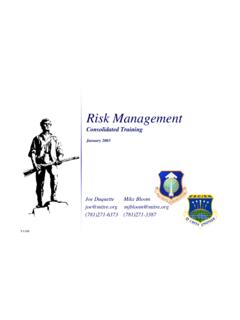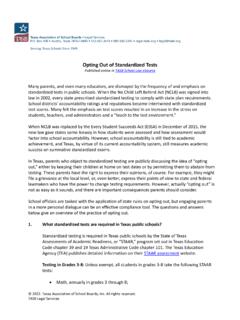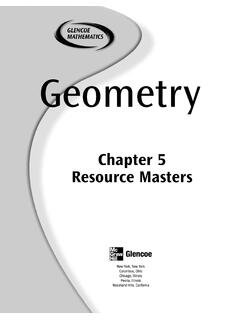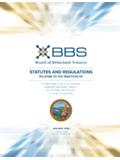Transcription of Standardized Technology Evaluation Process (STEP) User’s ...
1 Standardized Technology Evaluation Process (STEP). User's Guide and Methodology for Evaluation Teams Sarah Brown May 2007. 1. Table of Contents 1 Introduction 4. Purpose 4. Background 5. Intended Audience 5. How to Use this Document 5. 2 STEP Methodology 7. Evaluation Phases 7. STEP Workflow 9. Tailoring STEP 10. STEP Workflow for Small Evaluation Teams 10. STEP Workflow for Single Product Evaluations 11. 3 Guidance for Successful Evaluations 12. Methods Used to Evaluate and Score Products 12. Establishing Evaluation Criteria 13. Scoring the Products 14. Computing Weights 15. Computing the Overall Score for Each Product 19. Communication throughout the Evaluation Process 20.
2 Ensuring Evaluation Integrity 20. Creating an Evaluation Timeline 21. 4 Phase 1: Scoping and Test Strategy 22. Action: Conduct Preliminary Scoping 22. Action: Scoping with Government Sponsor 23. Action: Perform Market Survey/Tool Selection 24. Action: Determine Test Architecture 25. 2. Action: Draft High-Level Test Plan 25. Check Point Phase 1 26. 5 Phase 2: Test Preparation 28. Action: Establish Evaluation Criteria, Priorities, and Test Procedures 28. Action: Perform Government Requirements' Mapping 29. Action: Enhance and Finalize Test Plan 30. Action: Acquire Necessary Hardware and Software 31. Action: Hold Technical Exchange Meeting (TEM) (optional) 32. Check Point Phase 2 33.
3 6 Phase 3: Testing, Results, and Final Report 35. Action: Conduct Testing and Compile Results 35. Action: Perform Crosswalk 36. Action: Share Results with Vendors 36. Action: Deliver Final Report 37. Check Point Phase 3 39. 7 Acknowledgments 41. 8 References 41. Appendix A Acronym and Definition List 43. Appendix B STEP Templates 44. 3. 1 Introduction Purpose MITRE conducts numerous Technology evaluations for its sponsors each year, spanning a wide range of products and technologies. In order to keep pace with rapidly changing Technology and sponsor needs, MITRE Evaluation teams require a well-defined Evaluation Process that is efficient, repeatable, and as objective as possible.
4 The benefits of following a Standardized , effective Process include: Consistency and improved traceability through fixed steps and deliverables Improved efficiency leading to less effort required per Evaluation Defensible, repeatable results Better communication within and among Evaluation teams Evaluations that can be compared and shared more easily across the sponsor base An opportunity to develop guidance and document lessons-learned for future evaluations The Standard Technical Evaluation Process (STEP) developed in G024 outlines a rigorous Process for Technology evaluations of one or more COTS products1 . It applies to a variety of areas of Technology and provides substantial benefits for Evaluation teams and their government sponsors.
5 STEP aims to provide: A Process that can be used in a broad range of Technology evaluations Standard deliverables to achieve consistency, traceability, and defensibility of the Evaluation results Guidelines to assist teams in developing goals, documenting findings, and addressing challenges A Process that is recognized as comprehensive and fair This document presents STEP and offers a guide to Evaluation teams who wish to use it. From preliminary scoping to eventual integration and deployment, STEP guides teams in producing high quality reports, thorough evaluations, and defensible results. 1. Technology Evaluation is used in this document to refer to evaluations of multiple products providing the same capability.
6 Product Evaluation is used to refer to an Evaluation of a single product. 4. Background In 2004, the MITRE Intelligence Community Test and Integration Center in G024 began developing STEP in an effort to track past Evaluation work and ensure quality, objectivity, and consistency in future evaluations. Since that time, STEP has been used successfully in G024 as well as in G025, G027, and G151 Evaluation tasks. The four phases of STEP follow a common framework for conducting a Technology Evaluation . In developing and refining STEP, a variety of resources and subject matter experts were sought (see references in Section 8) within and outside of MITRE to gain a broader understanding of Evaluation theory and practice.
7 The STEP workflow and methodology incorporate many of these practices and recommendations. Intended Audience This document is intended for MITRE project leads and engineers conducting Technology evaluations of one or more products and is suitable for experienced as well as first-time evaluators. Although STEP was designed originally for several G024 security tool evaluations, the Process and methodology is applicable to any software or information Technology Evaluation . Because evaluations may vary significantly in size and scope, STEP presents options for Evaluation teams that would like to work in parallel for improved efficiency, as well as for smaller teams that wish to work together through each stage.
8 Together, the STEP workflow and methodology provide a comprehensive resource for teams wishing to standardize their evaluations and structure their daily activities. How to Use this Document Section 2 of this document provides guidance on four major challenges in Technology evaluations: using an established scoring method, communicating with the sponsor, ensuring integrity and defensibility, and forming a realistic Evaluation timeline. The remainder of the document provides specific information for executing each STEP action. The presentation in this document is based on the CEM Project Leader Handbook [8]. There is a chapter for the three main STEP phases and the chapters are designed so that the reader can quickly locate information about a specific action.
9 Each chapter contains: An overview of the phase A section for each action within the phase For each action: o Description: A description of the action and specific work to complete o Lessons-learned: Guidance for successfully completing the action o Templates and Sample Deliverables: A list of templates and deliverables from past evaluations to assist teams in documenting their work 5. The final STEP phase, Phase 4: Integration and Deployment, is outside the scope of this document and is not addressed in detail. Phase 4 applies if an Evaluation results in a purchase decision by the sponsor. In this case, the sponsor determines the specific actions required. 6.
10 2 STEP Methodology Evaluation Phases The STEP Process defines evaluations according to three main phases: (1) Scoping and Test Strategy, (2) Test Preparation, (3) Testing, Results, and Final Report, and a fourth, optional phase (4) Integration and Deployment that is determined by the sponsor on a case-by-case basis (Figure 1). Each STEP phase has different objectives, actions and associated document deliverables. Checkpoints, or control gates, separate the phases, and each phase must be completed before the next one is begun. These control gates help to ensure Evaluation integrity. For instance, teams must establish their Evaluation criteria and test strategy (Phase 2) before installing or testing the Evaluation products (Phase 3).







